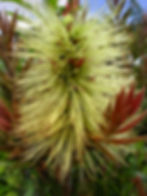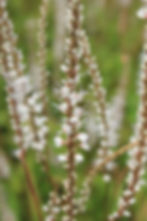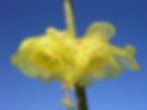A beginner's guide to understanding Botanical Latin - Colours
- iPlantsman
- May 11, 2020
- 8 min read
Updated: Aug 31, 2022
Botanical Latin, which incidentally often includes elements of Ancient Greek as well, is one of the more daunting elements of horticulture for most learning about the subject. At times seemingly impenetrable, some people find it an intimidating prospect to learn. While learning plant names definitely becomes easier with practise and regular exposure, understanding what the Latin means often gives you an advantage in understanding what a plant looks like, its qualities and even colours.

In this article, I want to look at Colour in Botanical Latin, but first I think it makes sense to explain just why we use Latin to name our plants.
Language is fluid; it changes over time and with regional users. We can easily see this when we look at the language one generation uses when compared with those of previous generations then those that follow. They all have unique words that mean less to the generations that preceded them and similarly will to those who follow them and yet the word meaning may continue unchanged over these generations.
Regionally and locally within a country colloquial words may be used that don’t appear elsewhere. These may also change over time.
Finally, the language we speak within individual countries will likely be different and may be difficult to translate and interpret.
All of this means that plant names, when spoken in a native tongue, in a local dialect, using colloquial names, by different generations, could mean that hundreds of people could be talking about the same plant with no person able to understand any others.
Latin and Ancient Greek are Dead Languages: they don’t change and won’t change. Any person, from any country, who normally speaks any language and uses their own local colloquial terms, can learn and use Botanical Latin internationally with any other person. This is fantastic tool.

We have Swedish Botanist Carl Linnaeus to thank for formalising the system of Binomial Nomenclature in the 1700's using Botanical Latin as the defining tool to name plants, animals and indeed all living things. Binomial Nomenclature translates to Two-Term/Name Naming System indicating the need for a Genus and species.

Genus is the group within which several genetically similar, but still different species will sit. For example, Humans are in the genus Homo along with some of our now extinct family tree including Neanderthals and others. Neanderthals are technically called Homo neanderthalensis (although they are possibly a subspecies of modern humans), while we modern human are called Homo sapiens, which means Wise Man (Wise = sapiens, Man = Homo). Genus are always written starting with a capital letter.
Species can be wildly different from one another, though they will share a genetic relationship having evolved from the same ancestors. Species names often describe the qualities of a plant, like flower colour, scent, size or plant or leaf, the habit in which it lives, etc, etc. Species are always written in lower case.
When printed, Botanical Latin is written in italics, with the exclusion of any Cultivar Names (they are for another article, but essentially consider cultivars to be plants that have been bred and do not occur naturally in the wild). For example Hebe pinguifolia all in italics, but the cultivated form of 'Pagei' is in quotations and not written in italics. Hebe pinguifolia 'Pagei'. All cultivar/variety names will be in quotation marks and should have capitals beginning each word (the capitalisation doesn't ways happen, but will apply 99% of the time).

This simple (at times) process of naming everything living using a universally followed system is a tremendous boon for the horticulturist. An international language that everyone can learn and use freely without it changing anywhere, ensuring that very specific plants are being described correctly by everyone.
Put simply, Botanical Latin is the only truly perfect solution for naming plants and if you work in horticulture in any form, you need to learn it. Keen gardeners may not need to know it, but they hopefully want to learn it and are definitely at an advantage if they do understand at least some of it.
Here we look at colour, which is often used in the species names of plants and generally helps us understand the colour characteristics of a plant.
For example Festuca glauca. Festuca are commonly called Fescue Grasses. There are over 400 different species of Festuca and although most have at least one common name, these depend very much on where you live. Festuca range significantly in size 10cm (4’) tall up to 200cm (6’+) tall and leaf colour. Without knowing exactly which species you wish to grow, you could end up with something radically different to your target plant. So then to the species name; glauca comes from glaucus, which in turn comes from the Ancient Greek ‘glaukós’ meaning Blue-Grey. Festuca glauca (commonly called the Blue Fescue) is well described by this name and can be instantly recognised and identified by that name.
Here are some other colour names used in Botanical Latin that may help give some clues to a plant’s qualities. This list is by no means exhaustive, but includes most of the commonly encountered examples.

Black -
species or cultivar names containing ‘melo’ or ‘melano’ tells us that something about the plant is Pure or Very Black. Example Salix gracilistyla ‘Melanostachys’
‘niger’ (pronounced as in the country/river) means Black and ‘nigrescens’ means Blackish. Examples Helleborus niger or Ophiopogon planiscapus ‘Nigrescens’ (Pictured Above)

Blue -
Species named ‘azureus’ can be assumed to be an Azure Sky Blue. Example Penstemon azureus and Vinca minor 'Azurea Flore Plena' (Pictured Above)
‘caeruleus’ or ‘caerulea’ indicate that the plant is a Bright Blue in colour. Example Passiflora caerulea
‘cyanus’ means Clear or Cyan Blue. Example Centaurea cyanus

Brown -
‘ferrugineus’ means Rusty Brown. Example Digitalis ferruginea (Pictured Above)
‘fuscus’ means Darkly/Blackish Brown. Example Cyprus fuscus
‘testaceus’ means Terracotta Red/Brown. Example Carex testacea

Green -
‘atrovirens’ means Dark Green. Example Thuja plicata ‘Atrovirens’
Words containing ‘chloro’ mean Clear Green. Example Chlorophytum comosum
‘virens’ means Verdant Green. Example Santolina virens
‘virescens’ means Greenish or Turning Green. Example Anemone nemorosa ‘Virescens’
‘viridis’ means Green. Nice a simple. Example Helleborus viridis or Callistemon viridiflorus (Pictured Above)

Gold and Orange -
‘aurantiacus’ means simply Orange. Several similar variants exist ending in ‘a’ or ‘um’ commonly. Example Mimulus aurantiacus
‘aureus/m’ means Golden Coloured. This could be considered orange or yellow potentially, though is probably most common when describing the colour yellow. Example Senecio aureus or Erigeron aureus (Pictured Above)
‘aureola’ means Halo, though technically a Golden Halo. Again could be said to be either more or less orange or yellow. Example Hakonechloa macra ‘Aureola’
'Chryso' means Golden. Example Salix x sepulchralis 'Chrysochoma'
'Chrysographes' means Gold Lined or Marked. Example Iris chrysographes

Purple -
Species or cultivars named ‘atropurpurea/s’ can be assumed to be Dark Purple in colour. Example Berberis thunbergii Atropurpurea Group. When you see a name followed by the word Group it indicates that there are several genetically similar forms grouped together under this name. In the example given of Berberis, there are a number of plants from cuttings and some from seed all sold under the same name. While they must all be purple in leaf, they may vary very slightly in leaf size, shade and plant size/habit. Groups don't get quotation marks as they cannot be given a single name to identify them.
‘purpurascens’ indicates Purplish colour or changing to Become Purple. Example Salvia officinalis ‘Purpuracens’ or Cerinthe major 'Purpurescens' (Pictured Above)
‘purpureum’ or ‘purpureus’ simply means Purple. Example Cistus x purpureus
‘violaceus’ or ‘violacea’ means Violet coloured. Example Tulbaghia violacea

Red -
'Cardinalis' means Cardinal Red. Example Lobelia cardinalis
'Coccineus' means Deep Carmine Red in colour. Example Hesperantha coccinea
'Cruentus' means Bloody. Example Dianthus cruentus
'Erythro' simply means red. Example Aesculus x neglecta 'Erythroblastos'. Incidentally, Blasto means Bud or Sprout, so you can imagine what part of the example is red.
'Flammeus' or similar derivative means Flame Coloured. Example Clematis flammula. Flammula means Little Flame, presumably relating to the seed heads resembling puffs of smoke as the plant otherwise has no obvious flame-like qualities.
'Igneus' men's Fiery Red. Example Dierama igneum
'Puniceus' means Purple-Red. Example Clianthus puniceus
'Rhodo' means simply Red. Example the Genus Rhododendron, or Rhodohypoxis
'Rosea/us' mean Rose-like or Pinky. Example Lavatera x clementii 'Rosea'
'Ruber' simply means Red, but unlike 'Rhodo' is more commonly used as a species or cultivar name rather than as part of the Genus name. Example Centranthus ruber
'Rubiginosus' means Rusty. Example Rosa rubiginosa
'Sanguineus' means Bloody or Blood Red. Example Heuchera sanguinea

Silver and Grey -
'Argenteus' means Shiny Silver or Lustrous. Example Salvia argentea or Cistus x argenteus 'Peggy Sammons' (Pictured Above)
'Canescens' means Whitish-Grey. Example Amorpha canescens
'Cinereus' means Ash-Grey. Example Geranium cinereum
'Glaucus' Overlapping from Blue, means Glaucos Blue-Grey. Examples Hebe glaucophylla
'Incanus' means Whitish Grey or Hoary. Example Salvia dorrii var. incana

White -
'Albescens' meaning Becoming White or Changing to White. Example Ribes sanguinea 'Albescens'
'Albicans' means Foamy White. Example Hebe albicans
'Alba' or 'Albus' generically means White. Example Cornus alba or Persicaria amplexicaulis 'Alba' (Pictured Above)
'Candicans' means Becoming White. Example Galtonia candicans
'Dealbatus' means Powdery White. Example Centaurea dealbata
'Galacto' means Milky White. Example Galanthus nivalis or Galactities tomentosa
'Lacteus' means Milky White, but probably tending toward a delight Blue. Example Cotoneaster lacteus
'Leuco' means White. Like 'Galacto' it is can appear in the Genus name also. Example Leucospermum, Leucadendron, Leucanthemum, or Salvia leucantha
'Nivalis' and 'Nivea' both Mean Snow White. Example Aquilegia vulgaris 'Niveum'

The example of Galanthus nivalis (Pictured Above) is an interesting one as the Genus name Galanthus come from the Greek gála meaning milk and ánthos meaning flower. The species then hammers home the white flower idea with nivalis also meaning white, specifically snow-covered or snow-like.

Yellow -
'Citrinus' means Lemon Yellow. Example Callistemon citrinus
'Croceus ' means Saffron Yellow. Example Lupinus croceus
'Flavens' or 'Flava' means Yellow. Literally 'Flava' means Flaxen or Golden Haired. Examples Disporum flavens or Sarracenia flava
'Flavescens' and derivatives mean Yellowish. Example Hedychium flavescens
'luteus' means generically Yellow. Examples Chimonanthus praecox 'Luteus' (Pictured Above), Solidaster luteus or Rhodendron (Azalea) luteum
'sulphureus' means Sulphur Yellow. Example Epimedium x versicolor 'Sulphureum'
'Xantho' means yellow and can be applied to a Genus or species. Example Xanthoceras sorbifolium or Viburnum opulus 'Xanthocarpum'
Selected Reading
Two books on Plant Names and Botanical Latin
Plant Names Explained: Botanical Terms and Their Meaning (Hillier Gardeners Guide) by Jane Sterndale-Bennet - An invaluable resource to help decipher the meaning of plant names
RHS Latin for Gardeners: Over 3,000 Plant Names Explained and Explored: More than 1,500 Essential Plant Names and the Secrets They Contain by Lorraine Harrison for the RHS - An excellent guide, somewhere between essential resource and coffee table book of old lithograph style images. Useful, but a bit illustrative for professional purposes.
A useful book on Colour Theory and Application
Color Choices: Making Color Sense Out of Color Theory by Stephen Quiller
My favourite books on Colour in a planted setting
The daddy of them all Christopher Lloyd Colour for the Adventurous Gardener
Color in the Garden: Planting With Color in the Contemporary Garden by Nori and Sandra Pope
365 Days of Colour in Your Garden by top garden designer Nick Bailey

Please note, the links to Amazon are paid affiliate links. If you purchase a product from Amazon, using this link I will receive a small payment from them. It doesn't cost you anything and the product is priced as per the Amazon price. Thanks
#binomialnomenclature #plant #naming #colour #color #botanicallatin #Latin #Greek #Black #Blue #Brown #Gold #Green #Orange #Purple #Red #Silver #Grey #White #Yellow #themeaningofnames #plantscience #botany #horticulture #beginnersguide #guide #hebe #salvia #salix #lupinus #viburnum #hedychium #epimedium #solidaster #rhododendron #azalea #rosa #disporum #sarracenia #galanthus #galtonia #cornus #aquilegia #leucadendron #leucanthemum #leucospermum #berberis #Linnaeus #homo #homosapiens #homoneanderthalensis #festuca #ophiopogon #helleborus #penstemon #passiflora #centaurea #digitalis #cyperus #carex #thuja #chlorophytum #santolina #anemone #mimulus #senecio #hakonechloa #iris #cistus #tulbaghia #lobelia #dianthus #aesculus #clematis #dierama #clianthus #rhodohypoxis #lavatera #heuchera #amorpha #geranium #ribes #galactities #callistemon #iplantsmanguide




